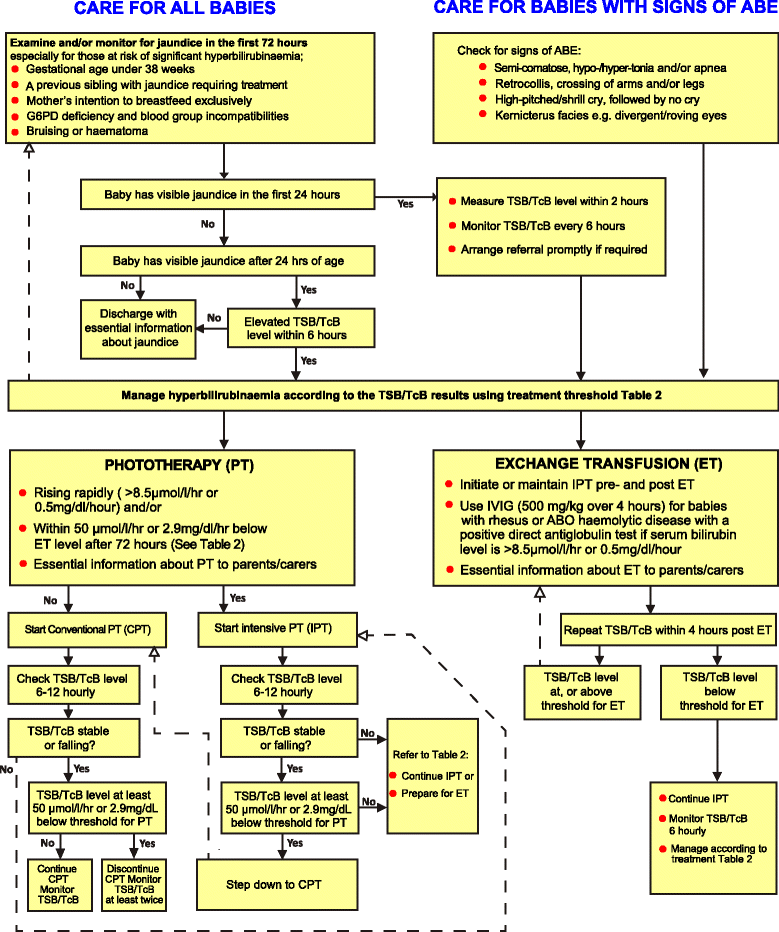Management of late-preterm and term infants with hyperbilirubinaemia in resource-constrained settings
- PMID: 25884679
- PMCID: PMC4409776
- DOI: 10.1186/s12887-015-0358-z
Management of late-preterm and term infants with hyperbilirubinaemia in resource-constrained settings
Abstract
Hyperbilirubinaemia is a ubiquitous transitional morbidity in the vast majority of newborns and a leading cause of hospitalisation in the first week of life worldwide. While timely and effective phototherapy and exchange transfusion are well proven treatments for severe neonatal hyperbilirubinaemia, inappropriate or ineffective treatment of hyperbilirubinaemia, at secondary and tertiary hospitals, still prevails in many poorly-resourced countries accounting for a disproportionately high burden of bilirubin-induced mortality and long-term morbidity. As part of the efforts to curtail the widely reported risks of frequent but avoidable bilirubin-induced neurologic dysfunction (acute bilirubin encephalopathy (ABE) and kernicterus) in low and middle-income countries (LMICs) with significant resource constraints, this article presents a practical framework for the management of late-preterm and term infants (≥ 35 weeks of gestation) with clinically significant hyperbilirubinaemia in these countries particularly where local practice guidelines are lacking. Standard and validated protocols were followed in adapting available evidence-based national guidelines on the management of hyperbilirubinaemia through a collaboration among clinicians and experts on newborn jaundice from different world regions. Tasks and resources required for the comprehensive management of infants with or at risk of severe hyperbilirubinaemia at all levels of healthcare delivery are proposed, covering primary prevention, early detection, diagnosis, monitoring, treatment, and follow-up. Additionally, actionable treatment or referral levels for phototherapy and exchange transfusion are proposed within the context of several confounding factors such as widespread exclusive breastfeeding, infections, blood group incompatibilities and G6PD deficiency, which place infants at high risk of severe hyperbilirubinaemia and bilirubin-induced neurologic dysfunction in LMICs, as well as the limited facilities for clinical investigations and inconsistent functionality of available phototherapy devices. The need to adjust these levels as appropriate depending on the available facilities in each clinical setting and the risk profile of the infant is emphasised with a view to avoiding over-treatment or under-treatment. These recommendations should serve as a valuable reference material for health workers, guide the development of contextually-relevant national guidelines in each LMIC, as well as facilitate effective advocacy and mobilisation of requisite resources for the optimal care of infants with hyperbilirubinaemia at all levels.
Figures
References
-
- Tomashek KM, Crouse CJ, Iyasu S, Johnson CH, Flowers LM. A comparison of morbidity rates attributable to conditions originating in the perinatal period among newborns discharged from United States hospitals, 1989–90 and 1999–2000. Paediatr Perinat Epidemiol. 2006;20:24–34. doi: 10.1111/j.1365-3016.2006.00690.x. - DOI - PubMed
-
- National Institute for Health and Clinical Excellence (NICE). Neonatal jaundice. (Clinical guideline 98.), 2010. www.nice.org.uk/CG98.
MeSH terms
Grants and funding
LinkOut - more resources
Full Text Sources
Other Literature Sources
Medical
Research Materials
Miscellaneous


